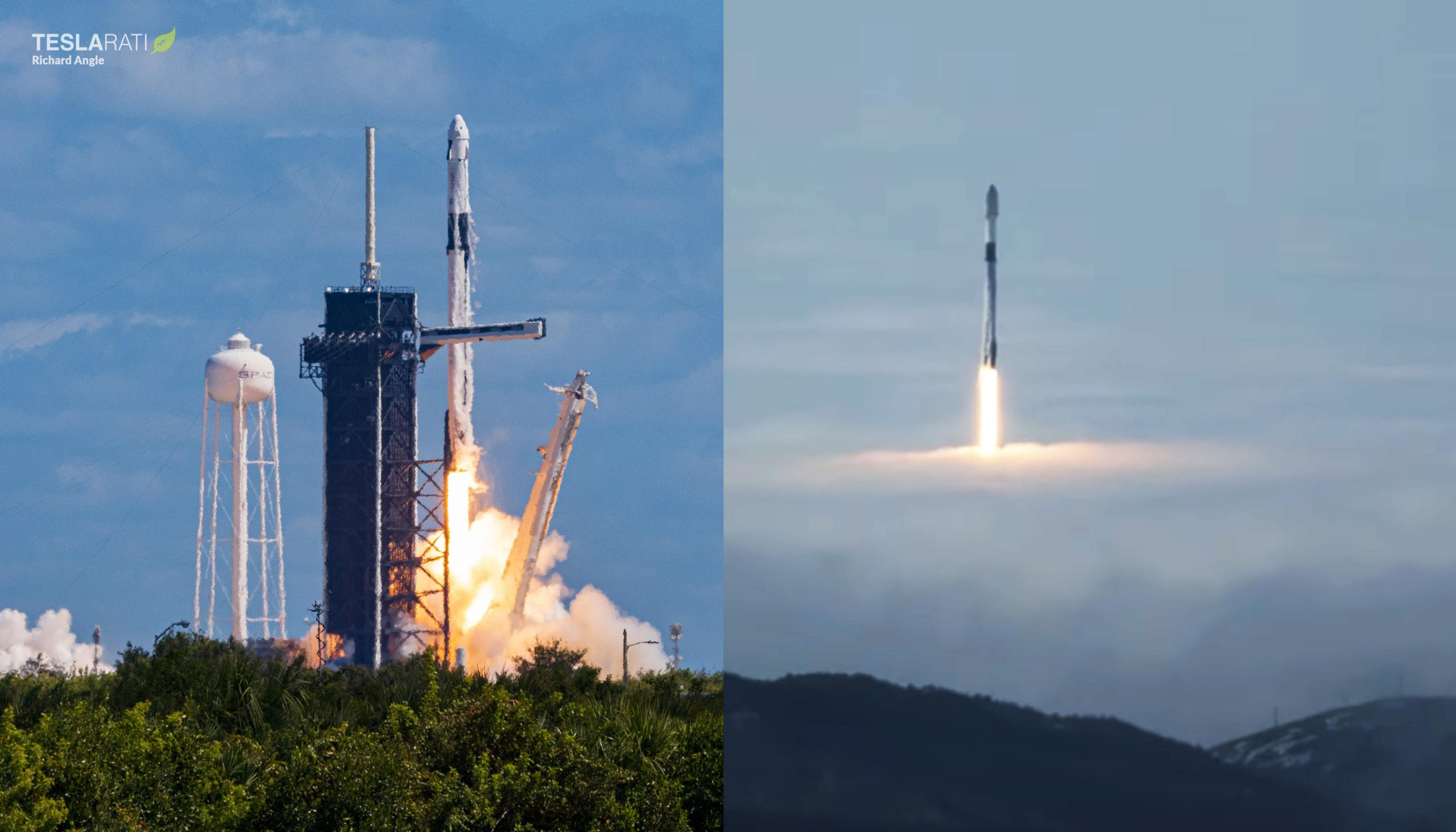
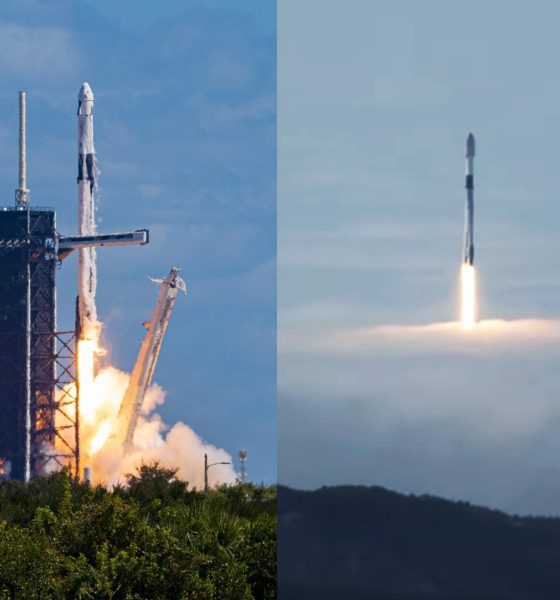
News
SpaceX launches two Falcon 9 rockets in seven hours
Two SpaceX Falcon 9 rockets have successfully launched a Crew Dragon carrying four astronauts and a new batch of Starlink internet satellites a little over 7 hours apart, nearly halving the company’s previous record.
A Falcon 9 rocket on the East Coast kicked things off with a launch out of NASA’s Kennedy Space Center (KSC) LC-39A pad – leased by SpaceX since 2014 – at noon EDT (16:00 UTC). A rare new Falcon 9 booster lifted an expendable upper stage and flight-proven Crew Dragon capsule – carrying four professional astronauts – most of the way free from Earth’s atmosphere before heading back to Earth and landing without issue on a SpaceX drone ship. The upper stage continued to low Earth orbit and deployed Dragon, kicking off a 29-hour journey to the International Space Station (ISS).
Seven hours and ten minutes later, a second Falcon 9 rocket lifted off from SpaceX’s Vandenberg Space Force Base (VSFB) SLC-4E pad, bursting through a thick layer of coastal fog. Following a successful launch and landing of booster B1071 and two good burns of the rocket’s upper stage, Falcon 9 deployed another 52 Starlink V1.5 satellites, adding to the more than 3000 working satellites already in orbit.
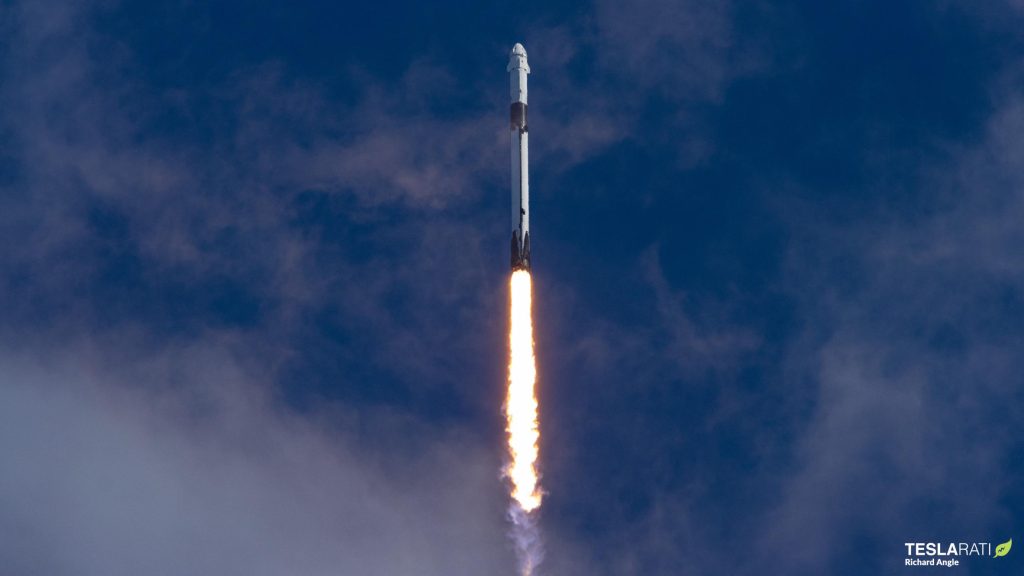
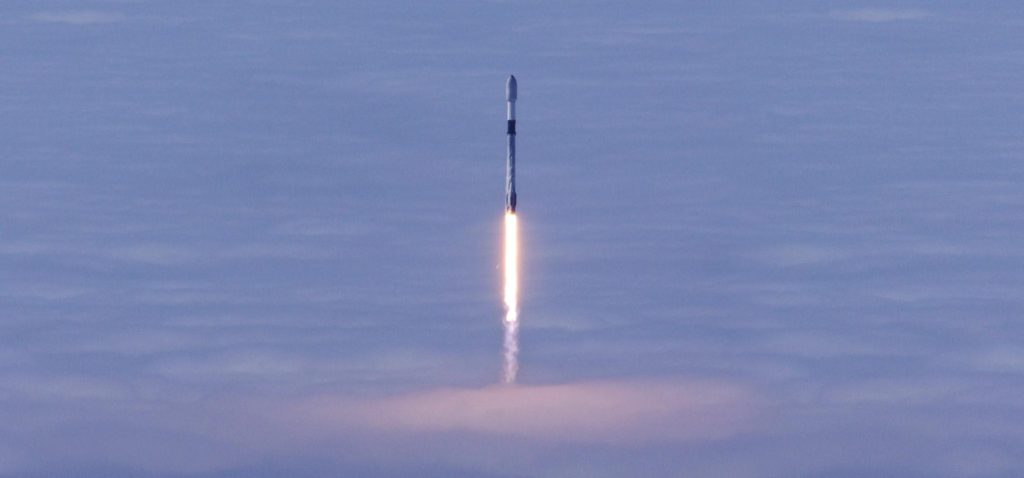
And SpaceX isn’t done. As early as 7:07 pm EDT (23:07 UTC) on October 6th, less than 24 hours after Starlink 4-29, a third Falcon 9 rocket is scheduled to launch from SpaceX’s Cape Canaveral Space Force Station (CCSFS) LC-40 pad. Rounding out the trio, the mission will carry Intelsat’s Galaxy 33 and Galaxy 34 communications satellites into a geostationary transfer orbit (GTO).
The mission will be Falcon 9 booster B1060’s 14th launch, significantly raising the bar for the commercial acceptance of reused SpaceX rockets. Prior to Galaxy 33/34, SpaceX’s commercial reuse record was held by Transporter-3, which was Falcon 9 B1058’s tenth launch.
The completion of two Falcon 9 launches in a little over 7 hours nearly halves SpaceX’s previous record of 14 hours and 8 minutes, set by a pair of launches in June 2022. It also demonstrates that the company can repeatedly prepare for and complete multiple Falcon 9 launches in very close proximity – more or less a necessity if it wants to hit CEO Elon Musk’s unprecedented target of “up to 100 launches” in 2023.
It isn’t a record for all of spaceflight, however. That likely falls to the Soviet R-7 family of rockets, 2 of which launched just 25 minutes apart in 1969. However, 3 Falcon 9 launches in 31 hours (Crew-5, Starlink 4-29, and Galaxy 33/34) is likely a record for all rockets. Parsing astrophysicist Jonathan McDowell’s extensive records, the R-7 family likely held the record for decades after completing 3 launches in 40 hours in 1978.
But, as it turns out, SpaceX already beat that record when it launched 3 Falcon 9 rockets in 36 hours in June 2022. 3 Falcon 9 launches in 31 hours thus breaks SpaceX’s record and the world record. That’s become an increasingly common occurrence for a company that has beaten its competitors so thoroughly that, by many measures, it has become peerless. Now, only the records of the former Soviet Union and a retired NASA rocket can outmatch SpaceX, a single 20-year-old company.
In less than three years, SpaceX has launched 30 astronauts: more than twice as many as China but a tiny fraction of the 852 people NASA’s Space Shuttle launched over its 30-year career. SpaceX’s Falcon family of rockets is the most reliable in history after 154 consecutive successes in less than six years, and Falcon boosters have completed more successful landings (145) than Space Shuttle orbiters. But its Dragon spacecraft will likely never best the Soviet and Russian Soyuz capsule and its variants, and Falcon will almost certainly be retired before it can come close to the R-7 rocket family’s extraordinary record of 1844 launches over 65 years.
But in the modern era, SpaceX is simply unmatched.
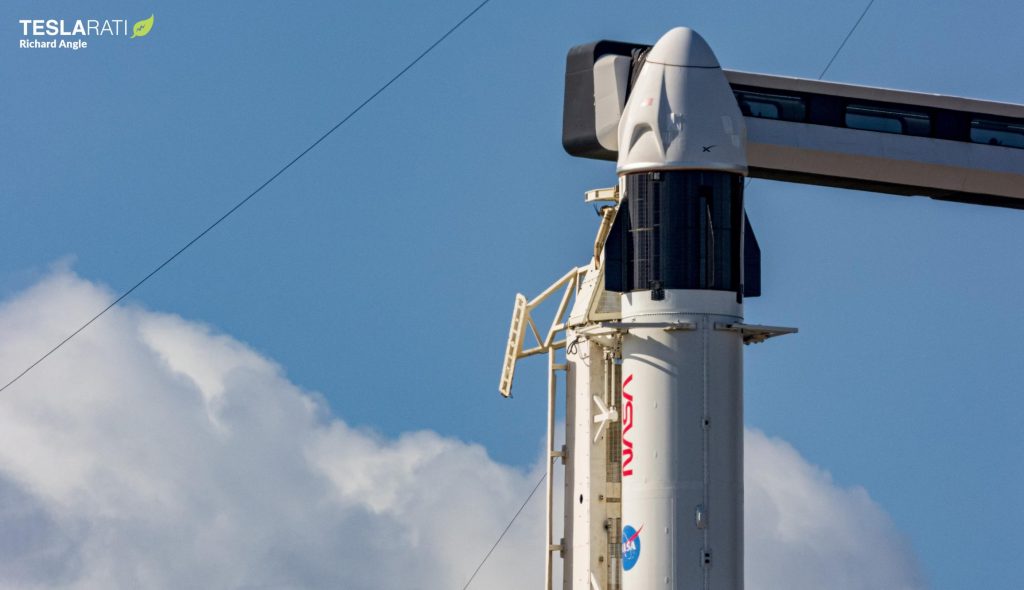
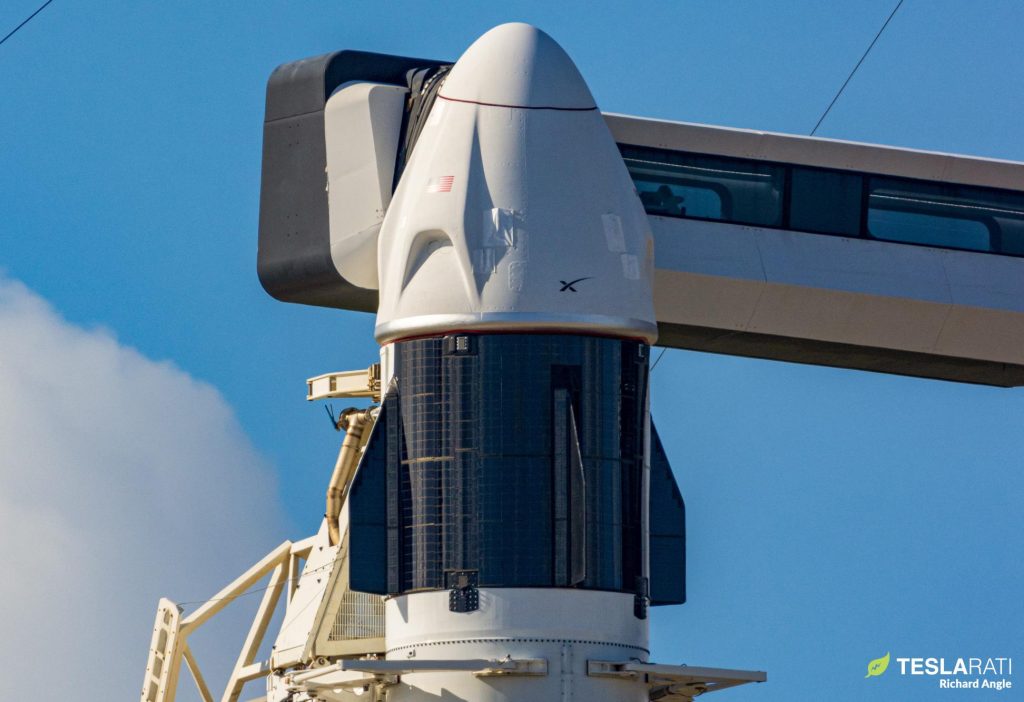



Elon Musk
Starlink passes 9 million active customers just weeks after hitting 8 million
The milestone highlights the accelerating growth of Starlink, which has now been adding over 20,000 new users per day.

SpaceX’s Starlink satellite internet service has continued its rapid global expansion, surpassing 9 million active customers just weeks after crossing the 8 million mark.
The milestone highlights the accelerating growth of Starlink, which has now been adding over 20,000 new users per day.
9 million customers
In a post on X, SpaceX stated that Starlink now serves over 9 million active users across 155 countries, territories, and markets. The company reached 8 million customers in early November, meaning it added roughly 1 million subscribers in under seven weeks, or about 21,275 new users on average per day.
“Starlink is connecting more than 9M active customers with high-speed internet across 155 countries, territories, and many other markets,” Starlink wrote in a post on its official X account. SpaceX President Gwynne Shotwell also celebrated the milestone on X. “A huge thank you to all of our customers and congrats to the Starlink team for such an incredible product,” she wrote.
That growth rate reflects both rising demand for broadband in underserved regions and Starlink’s expanding satellite constellation, which now includes more than 9,000 low-Earth-orbit satellites designed to deliver high-speed, low-latency internet worldwide.
Starlink’s momentum
Starlink’s momentum has been building up. SpaceX reported 4.6 million Starlink customers in December 2024, followed by 7 million by August 2025, and 8 million customers in November. Independent data also suggests Starlink usage is rising sharply, with Cloudflare reporting that global web traffic from Starlink users more than doubled in 2025, as noted in an Insider report.
Starlink’s momentum is increasingly tied to SpaceX’s broader financial outlook. Elon Musk has said the satellite network is “by far” the company’s largest revenue driver, and reports suggest SpaceX may be positioning itself for an initial public offering as soon as next year, with valuations estimated as high as $1.5 trillion. Musk has also suggested in the past that Starlink could have its own IPO in the future.
News
NVIDIA Director of Robotics: Tesla FSD v14 is the first AI to pass the “Physical Turing Test”
After testing FSD v14, Fan stated that his experience with FSD felt magical at first, but it soon started to feel like a routine.

NVIDIA Director of Robotics Jim Fan has praised Tesla’s Full Self-Driving (Supervised) v14 as the first AI to pass what he described as a “Physical Turing Test.”
After testing FSD v14, Fan stated that his experience with FSD felt magical at first, but it soon started to feel like a routine. And just like smartphones today, removing it now would “actively hurt.”
Jim Fan’s hands-on FSD v14 impressions
Fan, a leading researcher in embodied AI who is currently solving Physical AI at NVIDIA and spearheading the company’s Project GR00T initiative, noted that he actually was late to the Tesla game. He was, however, one of the first to try out FSD v14.
“I was very late to own a Tesla but among the earliest to try out FSD v14. It’s perhaps the first time I experience an AI that passes the Physical Turing Test: after a long day at work, you press a button, lay back, and couldn’t tell if a neural net or a human drove you home,” Fan wrote in a post on X.
Fan added: “Despite knowing exactly how robot learning works, I still find it magical watching the steering wheel turn by itself. First it feels surreal, next it becomes routine. Then, like the smartphone, taking it away actively hurts. This is how humanity gets rewired and glued to god-like technologies.”
The Physical Turing Test
The original Turing Test was conceived by Alan Turing in 1950, and it was aimed at determining if a machine could exhibit behavior that is equivalent to or indistinguishable from a human. By focusing on text-based conversations, the original Turing Test set a high bar for natural language processing and machine learning.
This test has been passed by today’s large language models. However, the capability to converse in a humanlike manner is a completely different challenge from performing real-world problem-solving or physical interactions. Thus, Fan introduced the Physical Turing Test, which challenges AI systems to demonstrate intelligence through physical actions.
Based on Fan’s comments, Tesla has demonstrated these intelligent physical actions with FSD v14. Elon Musk agreed with the NVIDIA executive, stating in a post on X that with FSD v14, “you can sense the sentience maturing.” Musk also praised Tesla AI, calling it the best “real-world AI” today.
News
Tesla AI team burns the Christmas midnight oil by releasing FSD v14.2.2.1
The update was released just a day after FSD v14.2.2 started rolling out to customers.

Tesla is burning the midnight oil this Christmas, with the Tesla AI team quietly rolling out Full Self-Driving (Supervised) v14.2.2.1 just a day after FSD v14.2.2 started rolling out to customers.
Tesla owner shares insights on FSD v14.2.2.1
Longtime Tesla owner and FSD tester @BLKMDL3 shared some insights following several drives with FSD v14.2.2.1 in rainy Los Angeles conditions with standing water and faded lane lines. He reported zero steering hesitation or stutter, confident lane changes, and maneuvers executed with precision that evoked the performance of Tesla’s driverless Robotaxis in Austin.
Parking performance impressed, with most spots nailed perfectly, including tight, sharp turns, in single attempts without shaky steering. One minor offset happened only due to another vehicle that was parked over the line, which FSD accommodated by a few extra inches. In rain that typically erases road markings, FSD visualized lanes and turn lines better than humans, positioning itself flawlessly when entering new streets as well.
“Took it up a dark, wet, and twisty canyon road up and down the hill tonight and it went very well as to be expected. Stayed centered in the lane, kept speed well and gives a confidence inspiring steering feel where it handles these curvy roads better than the majority of human drivers,” the Tesla owner wrote in a post on X.
Tesla’s FSD v14.2.2 update
Just a day before FSD v14.2.2.1’s release, Tesla rolled out FSD v14.2.2, which was focused on smoother real-world performance, better obstacle awareness, and precise end-of-trip routing. According to the update’s release notes, FSD v14.2.2 upgrades the vision encoder neural network with higher resolution features, enhancing detection of emergency vehicles, road obstacles, and human gestures.
New Arrival Options also allowed users to select preferred drop-off styles, such as Parking Lot, Street, Driveway, Parking Garage, or Curbside, with the navigation pin automatically adjusting to the ideal spot. Other refinements include pulling over for emergency vehicles, real-time vision-based detours for blocked roads, improved gate and debris handling, and Speed Profiles for customized driving styles.








